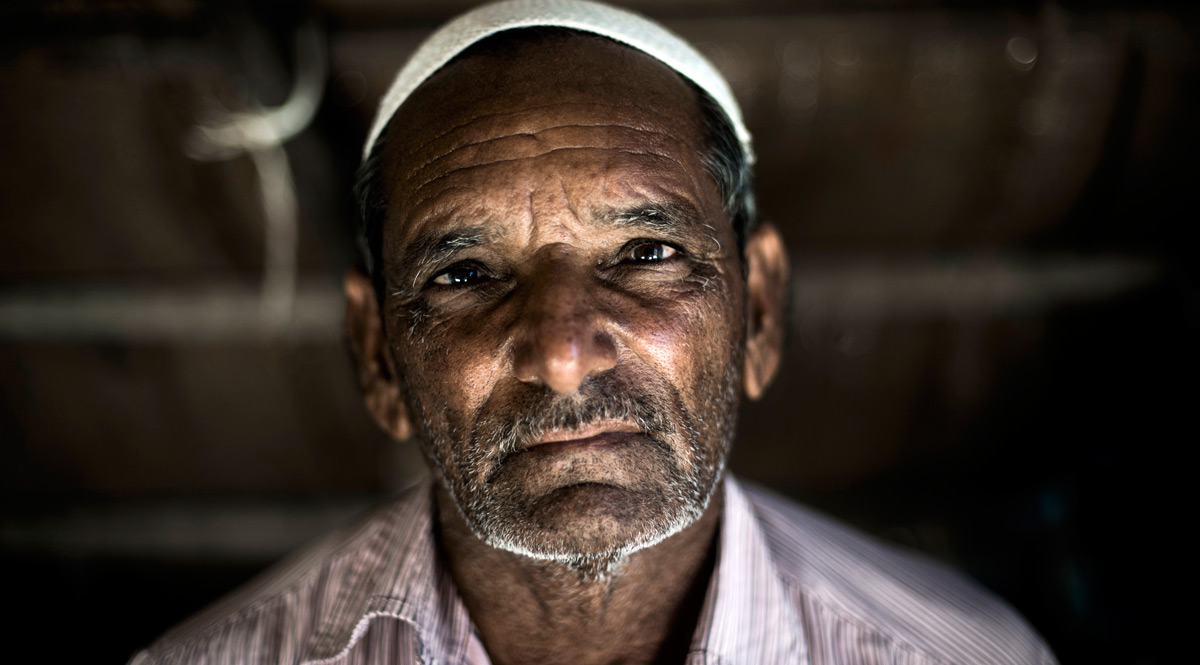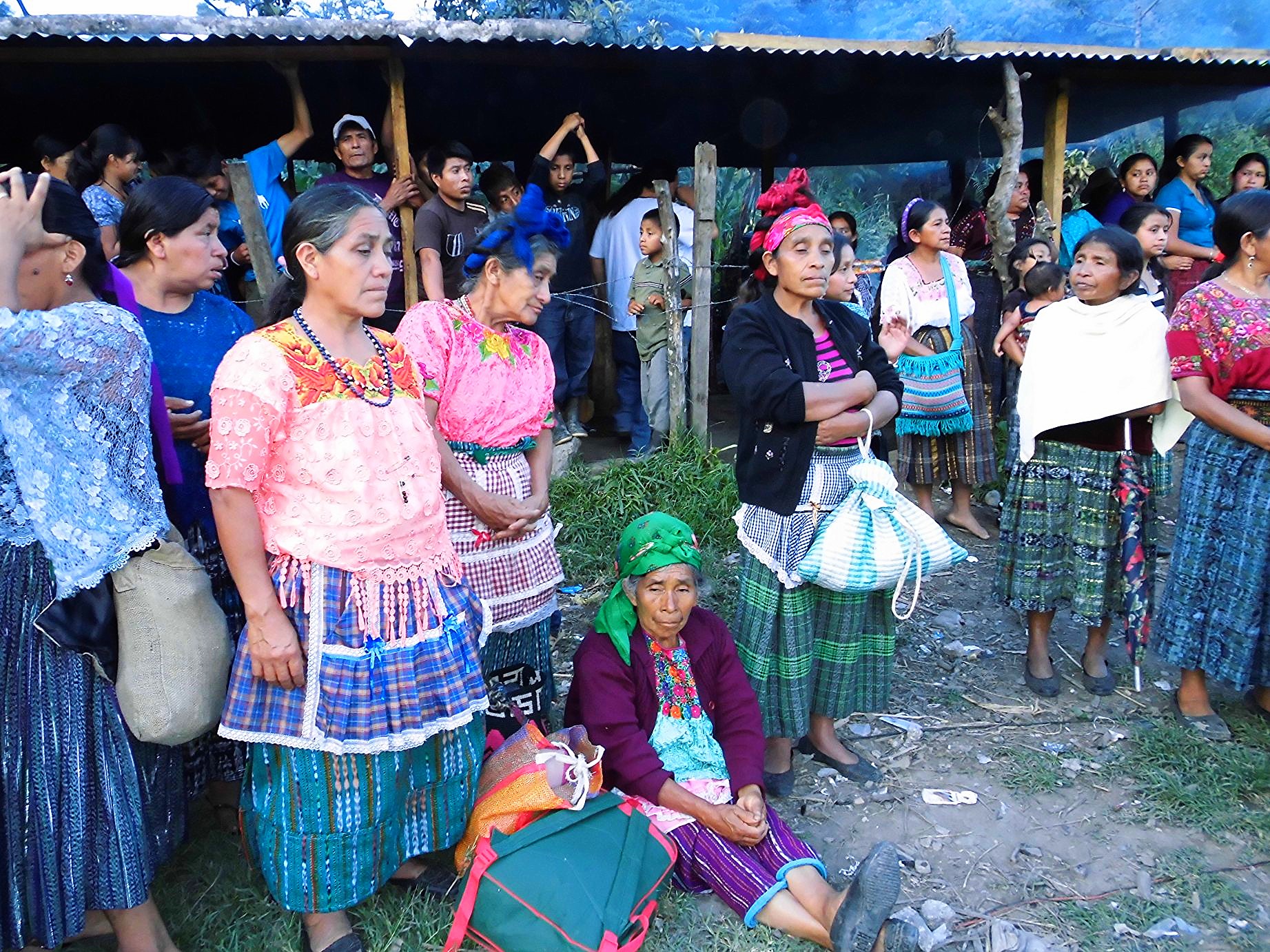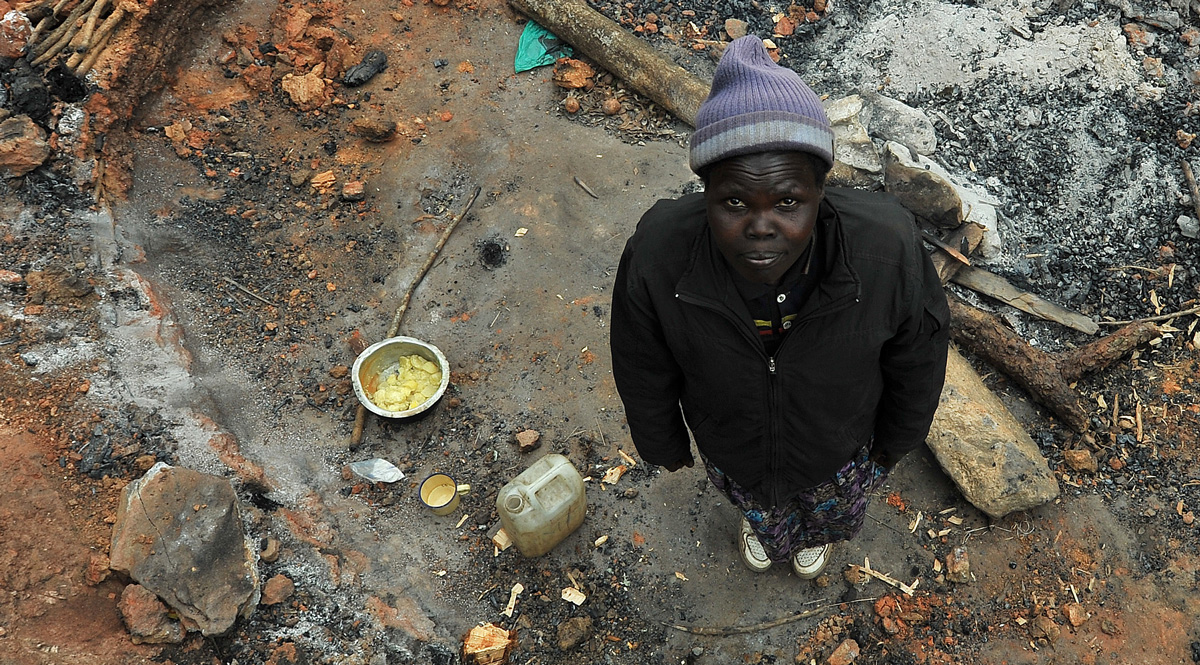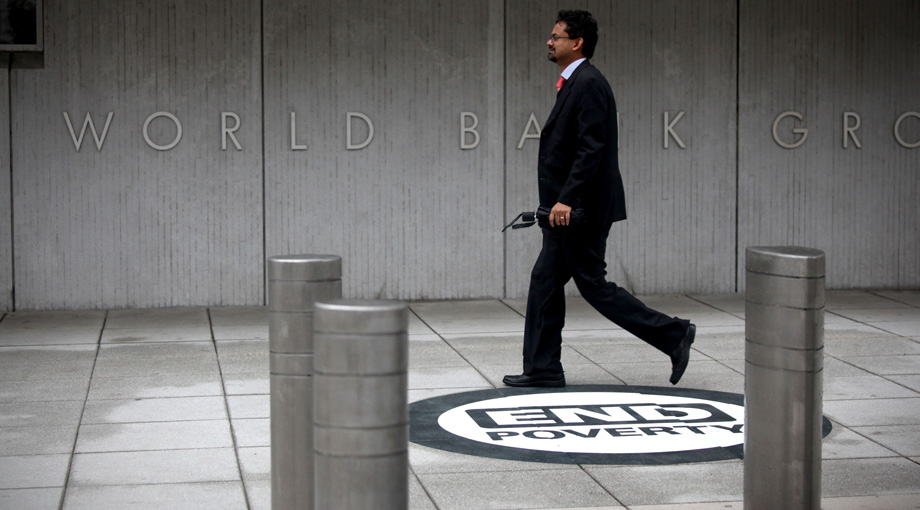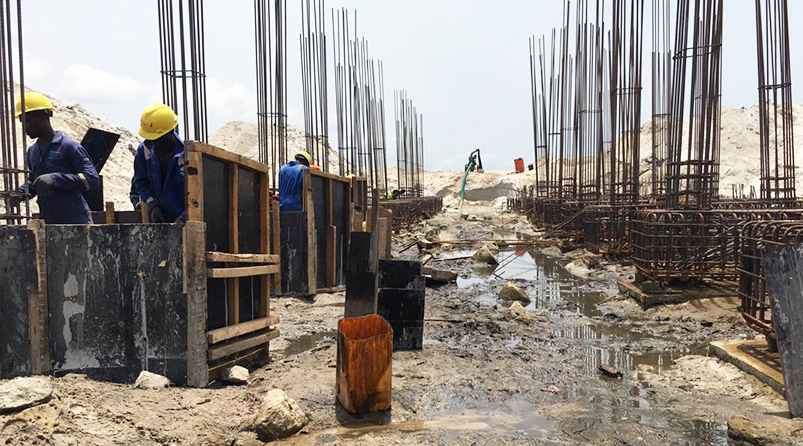The Tata group, one of India’s largest conglomerates, promised to be a good neighbor when it took on the job of building the nation’s first “ultra mega” coal-fired power plant.
The plan was to build the plant along the Gulf of Kutch, an inlet of the Arabian Sea that provides a living for fishing clans that harvest the coast’s rich marine life. Tata assured the World Bank Group, which was putting up $450 million to help finance the project, that there was little reason to worry about the giant plant’s impact on people living and working nearby.
Tata reported that “the fishing potential of the Gulf of Kutch is significant,” but there were “no local fishing activities in the coastal waters fronting the project.” The “nearest small fishing community,” it said, was located “outside the project area.”
This came as a surprise to Budha Ismail Jam.
Jam spends most of the year living in a one-room hut on Tragadi Bandar, a makeshift fishing settlement that borders the Tata Mundra Ultra Mega Power Project in the western state of Gujarat, 100 miles south of India’s border with Pakistan. All that separates the settlement from the Tata plant, completed in 2012, is a man-made channel that releases heated wastewater from the 4,150-megawatt operation. The channel was cut from land where, until recently, fishing families lived. Beyond it rises the plant’s twin red-and-white striped smokestacks, visible for miles across the flat landscape.
Jam belongs to a Muslim minority group called the Waghers, whose history on the coastline dates back 200 years, according to their fishing association. Every summer, about 1,000 Wagher families – as many as 10,000 men, women and children – load their possessions onto rented trucks and migrate from their inland villages to the sandy fishing grounds along the gulf. They rebuild their settlements from scratch, framing huts from wooden branches and covering them with burlap walls, and live there for eight months without electrical connections or running water. The men haul in the daily catch. The women sort the fish and hang the most pungent species, Bombay duck, on bamboo trellises to dry. Much of the product gets shipped across India and to Bangladesh, Sri Lanka and Nepal.
“Those people say there are no fisherfolk here,” says Jam, who is in his mid-50s and dresses in the loose-fitting white clothing and knit skullcap of many Wagher men. “There are a lot of us here.”
The coming of the Tata plant and other industrial projects, though, has made it harder for them to make their living on the coast.
Residents of Tragadi Bandar claim in a lawsuit filed April 23 in U.S. federal court in Washington, D.C., that warm water discharged by the Tata plant has driven fish away from the intertidal zone, where the Waghers used to practice pagadiya, a traditional method of setting up nets and harvesting the fish at low tide. The returns from boat fishing, which takes place farther from shore, have also fallen off.

“You see this produce here?” says Jam, sweeping his arm across a view of his bandar, one of several fishing settlements along the gulf. Burlap bags stuffed with dried Bombay duck sit on the sand waiting for market. “We used to get this much business in one day. Now it takes 15.”
Jam and his neighbors are among the uncounted: people the World Bank Group and its borrowers have ignored in their push to create dams, power plants and other projects.
The global institution’s two main lenders – the World Bank, which lends to governments, and the International Finance Corporation, which lends to corporations such as Tata – have repeatedly failed to make sure people harmed by big projects get counted, an investigation by the International Consortium of Investigative Journalists has found.
Both lenders have detailed policies that require that their borrowers identify people whose homes or land will be lost or livelihoods will be damaged as a result of the projects they finance.
When “project-affected people” are identified, borrowers must resettle them into new homes or help restore their livelihoods. But if people don’t get counted, they’re unlikely to get help from the lenders and their borrowers in putting their lives back together.
In some cases, the IFC and the World Bank have declined to count entire populations that claim they’ve been harmed by projects backed by the lenders. In Kenya and Ethiopia, indigenous groups claim that World Bank cash bankrolled mass evictions that targeted them for threats, violence or arbitrary arrests. The World Bank denies its money was used for these evictions.
In other cases, the World Bank has acknowledged that large numbers of people would be harmed by development initiatives, but allowed its borrowers to underestimate the real number.
A 2012 internal review of nine World Bank-supported projects found that the number of affected people turned out to be, on average, 32 percent higher than the figure reported by the bank before approving the initiatives, understating the number of people affected by the nine projects by 77,500. This echoed a broader internal review in 1994, which looked at 192 projects and found that the real number of affected people averaged 47 percent higher than previously estimated.
In March, a World Bank spokesman acknowledged that the bank-financed Nam Theun 2 dam in Laos has physically displaced or economically affected more than 75,000 villagers – a 50 percent increase over the 50,000 figure that the bank had reported before it approved the project in 2005.
Independent researchers who have studied the project estimate that the number of people who have been harmed by the dam’s construction is larger than even bank’s updated number – reaching as high as 130,000 to 150,000.
Bruce Shoemaker, a researcher on natural resources issues who worked on the independent review, says villagers downstream from the dam have suffered a drop in wild fish catches, excessive flooding of their rice fields and other impacts on their livelihoods. The failure by World Bank and Laotian officials to recognize the dam’s full effects on people above and below the dam means that the compensation offered to farmers and fisherfolk “didn’t come close to making up for their losses,” Shoemaker says.
World Bank officials say they disagree with the larger estimate reached by Shoemaker and his co-researchers. “We are always willing to consider independent studies that focus on our projects,” David Theis, a bank spokesman, said in a written statement. “In this case, our extensive and detailed research and analysis has yielded different facts, which we stand by.”
The bank says most people affected by Nam Theun 2 are better off than they were before, with surveys showing many families having more savings and assets and fewer underweight children.
The bank says the increase in the numbers of people identified as being affected by the dam came because the project’s managers used a broader definition of affected households. In other cases, bank officials have attributed shifting numbers for people harmed by projects to later expansions in projects’ size or to population growth during projects’ long time windows.
Theis said that despite the complex challenges of keeping track of people affected by development, “we are going to be extremely vigilant about our work in this area. When our work does involve relocation, we will do so as long as we can improve or at least restore people’s incomes and living conditions.”

Early warning
The problem of undercounting resonates in the Indian state of Gujarat, the site of a mammoth debacle that was supposed to transform the World Bank’s approach to development and displacement. In 1985, the bank pledged $450 million to finance the Sardar Sarovar dam and canal, the keystone of an effort to turn the Narmada River into a series of reservoirs that would serve the state’s most drought-prone regions.
The bank estimated in 1987 that 60,000 people would be affected by the project. By 2000, the World Commission on Dams, a study group co-sponsored by the World Bank, put the figure at more than 200,000. Current estimates from NGOs monitoring the project indicate more than 250,000 will be impacted by the dam, which is in now in its final stages of construction. Many of the displaced, like the Wagher fishing families, had no title to the land they occupied. World Bank policies explicitly state that residents without title still qualify for compensation and resettlement assistance.
Experts found – in the words of one panelist – “a rather terrifying ignorance” on the bank’s part about the human consequences
Planning for Sardar Sarovar began with an “elaborate Government pantomime of conducting studies to estimate the actual project costs and the impact it would have on people and the environment,” the famed Indian novelist and activist Arundhati Roy later wrote. “The World Bank participated wholeheartedly in the charade – occasionally it beetled its brows and raised feeble requests for more information on issues like the resettlement and rehabilitation of what it calls ‘PAPs’ – Project Affected Persons. (They help, these acronyms – they manage to mutate muscle and blood into cold statistics. PAPs soon cease to be people.) The merest of crumbs satisfied the Bank and it proceeded with the project.”
Resistance was fierce. Protesters blocked roads and barred government officials from their villages. Some pledged to drown rather than leave their land. Police met Gandhi-style nonviolence with beatings and arrests. After activists launched a hunger strike, the World Bank agreed to an independent review by an expert panel.
These experts found – in the words of one panelist – “a rather terrifying ignorance” on the bank’s part about the dam’s human consequences. No one knew how many people would be ousted, and there was little preparation, or even available land, for resettling them. After the panel issued its 363-page report, the bank announced in 1993 that it would withdraw from the project, canceling the last $170 million of its loan. By then it had disbursed $280 million, and the Indian government found other funding to make up the difference. Construction proceeded.
In the wake of the protests, World Bank officials pledged to pay more attention to the social dimensions of civil-works projects. “After the Narmada project, it became clear that giving affected people a voice was critical,” E. Patrick Coady, a former U.S. executive director for the World Bank, later said.
Ultra Mega

The first of these privately run “Ultra Mega Power Projects” would front the Gulf of Kutch, near the town of Mundra in Gujarat. Tata Power, part of a $100 billion conglomerate that produces everything from Tetley Tea to Jaguar sports cars, won the contract to build and operate the plant. To put together the financing for the $4.1 billion project, Tata sought help from the World Bank Group’s International Finance Corporation.
For the World Bank Group, the project came with public relations risks. It was under pressure to stop financing carbon-spewing coal plants. And it had been burned before in India by Narmada and by other big projects that spawned evictions and protests.
Tata and the Indian government promised that the new coal plant would be different. It would burn imported coal using a high-temperature technology that emits fewer greenhouse gases. And the company insisted that the people affected by the plant would be identified and protected.
Tata’s planning documents noted that some villagers would lose farmland, access to communal grazing land and, in a few cases, their homes. (It described those losses as “marginal.”) Those same documents – along with other studies produced by the company and the government – were generally silent about, or dismissive of, the Wagher fishing communities. Impacts on fisheries, an Indian government report said, would be “minor and non-consequential.” Ten months later, Tata identified three villages that would be affected by the power plant. It listed their total fishing population as zero.
Advocacy groups say the failure to count the Wagher fishers shows the World Bank and the IFC haven’t learned from the Narmada ordeal or other projects that failed to fully acknowledge their impacts on people.
“What they have done in Mundra is not unique,” says Joe Athialy, acting Asia director for the Bank Information Center, an NGO that pushes for greater local participation in development decisions. “This is happening project after project, sector after sector.”
Best practices
The sun sets on Kutadi Bandar. Young men throw anchors and buoys onto the wooden boats at the shoreline. They untangle thick rolls of green netting, occasionally breaking into song, preparing for an overnight trawl.
Nearby, outside a hut, neighbors sit and listen – men on one side, women on the other – as an elder with a white beard and turban recites poetry about brotherhood and the folly of greed. Donkeys bray. Women cook flatbread over open fires. A three-wheeled auto-rickshaw arrives from the market, bringing empty foam coolers that, with any luck, will be filled with fish when the boats return. As the night darkens, those with portable solar panels turn on the lights inside their dwellings. In the distance, the Tata Mundra power plant twinkles like a galaxy.

The sense of enterprise on this bandar, just east of Tragadi Bandar, is palpable. So is the sense of worry. Fishers here have nostalgic memories of practicing pagadiya, or foot-fishing: waking up at 5 a.m., drinking tea together inside their huts, and then wading into the water in teams of four to harvest the fish that had gotten entangled in the nets.
Nowadays, Kutadi’s fishers need to travel farther into the gulf to bring back diminishing catches. Some weeks they make no money and have to ask local fish merchants to front their expenses. “We beg them to give us loans,” says Jubedaben Manjaliya, the matriarch of a three-generation household.
Ask the men about stress and they show their blood-pressure medications. Yunus Suleman Gadh, 48, pulls out a receipt with the proceeds from 15 days’ catch: 1,400 rupees, just under $23. “Sometimes we feel that we should stop fishing. Just stop and no more, that’s it,” he says. “Then what will we do? Lift loads on our shoulders and do heavy labor? No one is going to hire us for labor. We will have to beg by telling stories.”
The problems on Kutadi Bandar started before Tata’s arrival.
Some of its fishers have moved twice since the late ’90s, according to Bharat Patel, general secretary of the local fishers’ organization MASS (Machimar Adhikar Sangharsh Sangathan, or Association for the Struggle for Fishworkers’ Rights). First they were displaced by the construction of India’s largest private port. Then came a second move to make way for the intake channel built originally for Mundra’s other coal-fired thermal plant, owned by Adani Group, a conglomerate based in Gujarat. As industry took over the coastline, studies chronicled wholesale mangrove destruction – “bulldozed or burnt down, leaving no trace,” H.S. Singh, Gujarat’s chief forest conservator, told India’s Financial Express in 2007 – and dredging that filled the creeks.
The Tata plant, built next to Adani’s and sharing the same intake channel, was supposed to be more ecologically and socially friendly. Officials with the World Bank Group’s IFC unit noted that Tata had a track record of partnership with the IFC and was widely considered to be a good corporate citizen. And its plant would be planned and constructed under the IFC’s detailed rules for protecting people and the environment.
The IFC responded to questions for this article by quoting its own website, which says its investment in the Mundra plant ensured “the best international industry practices.”
Out of balance
In 2011, 10 months before Tata’s coal-fired plant opened, the fishers’ group MASS filed a complaint with the Compliance Advisor Ombudsman, the IFC’s internal watchdog unit. The IFC ignored its own policies by allowing Tata to exclude fishing communities from the list of people harmed by the project, the complaint said.

MASS also asked the National Fishworkers Forum to send an independent fact-finding team to Mundra. The team, which included a retired judge and a marine scientist, visited shortly after the plant opened and met with both fishers and Tata managers. Its 2012 report described a project that “has been marred with serious social and environmental impacts,” while those harmed were largely excluded from the deliberations. Tata Power notes there were public meetings to discuss the plant, including a hearing in Mundra that drew 250 people. The fact-finding team located people who attended those meetings, but said no one “could remember any material being distributed . . . in any languages they understand.”
Many of the meetings were sparsely attended. “We didn’t know the meaning of ‘public hearing’ back in those days,” says Manjalia Ibrahim Sale Mohammad, a Wagher elder. “So we didn’t go.”
During visits to the Tata site, the fact finders witnessed heavy equipment “leveling and clearing the coastal mud flats” and reviewed MASS’ photos of mangrove destruction. Fishers pointed out creeks damaged by dredging. Tata insists it harmed no mangroves or “biodiversity rich creeks.”
The research team’s tests revealed the water discharged from the plant near Tragadi Bandar was higher in oxygen-depleting contaminants and warmer than the Gulf of Kutch’s waters. Its temperature was 32 to 33 degrees Celsius, far higher than the gulf’s average surface temperature of 26.1 degrees. “Fish tend to move away or suffer in abundance even with a 1°C change,” the report said. “Thus, four to five degrees warmer water falling into the Gulf throughout the year is sure to … drive away most fish species.”
Tata says its discharge is cooled to a safe temperature and contains no chemicals, and that its seawater monitoring shows “no adverse change.”
The researchers disagreed, concluding that ecological changes caused by the plant have harmed the Waghers’ ability to earn a living from the water.
“The boats used by the local fisher people are … small, thus preventing them from venturing out to the open sea – which they have no experience of, or had no need for – as the interior of the Gulf was a plentiful source of fish until recently,” the researchers wrote. “The centuries-old balanced existence is now changing for the worse, negatively impacting fisher-people who are themselves not responsible for this change.”
Rising hopes

Tata reported no data about the residents of Tragadi and Kutadi bandars, the audit noted. Key documents scarcely mentioned them and the “IFC paid insufficient attention” to this omission.
Consultations with fishers were not “effective or timely,” despite indications bandar residents would be “physically and economically” displaced. This was particularly worrisome, the report said, because Muslim Waghers – whose Hindu vegetarian neighbors often view fishers with disdain – are “statutorily recognized as educationally and socially disadvantaged and acknowledged by IFC to be vulnerable.”
The audit report added that the IFC didn’t do enough to investigate the power plant’s marine impacts and failed to consider all the ways the Tata plant might contribute to the cumulative impacts of industrialization along the coast.
The report spawned rising hopes among the fisherfolk. “There was a sense of confidence: ‘OK, a body from within the World Bank Group has come out strongly in our favor,’” says Himanshu Damle, a researcher with the Bank Information Center. “Expectations rose as a result of that, thinking that the World Bank president would step in.”
Instead, IFC officials issued an 11-page response denying that the fishers were displaced. The bandars, it said, are “temporary in nature,” and even though some bandar land was taken, enough remained for the fishers to return. The IFC said the seawater and marine life would be fine and that no additional impact studies were needed.
World Bank Group President Jim Yong Kim signed off on the IFC’s response without comment.
Since then, human-rights groups and other NGOs around the world have targeted Kim with letters protesting his rejection of his own watchdog unit’s findings. “Your decision means thousands of fishing and fishworker families will continue suffering,” said one plea signed by 68 organizations from the U.S., Indonesia, Vietnam and elsewhere.
And on April 23, some of the plant’s frustrated neighbors took their fight to the city where the World Bank is headquartered, signing onto a lawsuit filed against the IFC in U.S. District Court in Washington, D.C., by the nonprofit EarthRights International. The suit accuses the lender of violating its own mission of promoting sustainable development while doing no harm. The IFC failed “to prevent and mitigate harms to the property, health, livelihoods, and way of life of many of the people who live near the Tata Mundra Plant,” says the complaint. “The Tata Mundra Plant is thus a mission failure.”
The plaintiffs, including Budha Ismail Jam and the fishers’ organization MASS, are seeking class-action status.
The IFC declined to comment on the lawsuit’s claims.
The price
The controversy over the coal-burning plant on the Gulf of Kutch comes at a bad time for the World Bank Group, which has been trying to position itself as a leader in the fight against climate change. The bank’s governing board pledged in 2013 to limit its funding for coal-burning plants to “rare circumstances.”
The IFC’s decision to invest in the Tata plant has become more difficult to defend as the company has wavered on its central promise – providing low-cost electricity to 16 million Indians across five northern and western states.
Tata buys its coal for the Mundra plant from Indonesia, which raised its export prices in 2011 to benchmark them to the international market. Because Tata won its bid on the promise to sell energy at a certain price, it now loses money on every kilowatt it generates at the plant. In 2013, at the company’s request, a federal agency approved a 23 percent rate hike. The increase was blocked last year, at least temporarily, by India’s Supreme Court.
Justin Guay, an energy lending expert and former Washington representative for the Sierra Club, says the Tata case violates the uneasy social contract surrounding coal in the developing world.
“The quid pro quo is that society gets cheap abundant electricity, but it comes at quite a bit of cost,” he says. “They justify those costs because it’s the only thing poor countries can do to help lift themselves out of poverty.” With Tata petitioning to raise its rates, “that social contract – even if it ever was a justifiable contract – has completely broken down.”
Tata Power declined three interview requests for this story. The company referred queries to the public-relations firm Edelman, which invited written questions and then declined to answer them.
In a broad written response focusing on the plant’s local impacts, the PR firm said the company is “very conscious of its impact on its community and environment and tirelessly works towards mitigating any impact.” It said Tata follows all environmental rules and works with “target neighboring communities” to improve “their quality of lives.”
The Big Boss
In its marketing literature, Tata stresses its social investment in the Mundra area. It says it has stepped up its outreach to the Waghers, providing solar boat lights and running gynecology and malaria camps at the bandars. Tata also delivers drinking water to Tragadi Bandar, which had a well that was destroyed during the dredging of the plant’s wastewater channel, according to MASS’ Bharat Patel.
Wagher fishers say Tata has done some community outreach, but they call it selective and inadequate. Budha Ismail Jam and Yunus Suleman Gadh say the boat lights were subsidized, not distributed for free, and not made available to everyone. Jam says Tata has been delivering only half of the promised water. Tata declined to comment on water deliveries.
The IFC maintains that Tata is doing a good job dealing with locals’ concerns. In January, in response to a follow-up report from the ombudsman’s office, IFC management released a statement praising Tata for being “actively engaged with the fishing community” and noting that studies are being planned to assess the power plant’s environmental and socio-economic impacts – “both positive and unfavorable” – on the Mundra coast.
The ombudsman unit’s follow-up review, released Jan. 14, acknowledged these efforts, but said the IFC and Tata still haven’t done enough to correct the violations that sparked the fishers’ complaint in the first place. It said the “completion of studies that were required prior to construction of the project” might, at this late date, be too little, too late.
For their part, Wagher fishers say consultations and corporate charity can’t compensate them for the damage to the gulf – and to their lives.
Manjalia Ibrahim Sale Mohammad recalls two visits from Tata managers while the plant was being built, seeking the elder fisherman’s cooperation.
“They told me: Whatever you ask of us, we will try to provide you,” he says. “I told them: If I need anything, I ask the sea, because he is the big boss. Whenever one goes to the sea, he makes at least 2,000 to 5,000 rupees a day” – $32 to $81. “Are you going to give us this every day? No.”
Barry Yeoman is a U.S.-based magazine journalist. This article was reported in partnership with The Investigative Fund at The Nation Institute.
